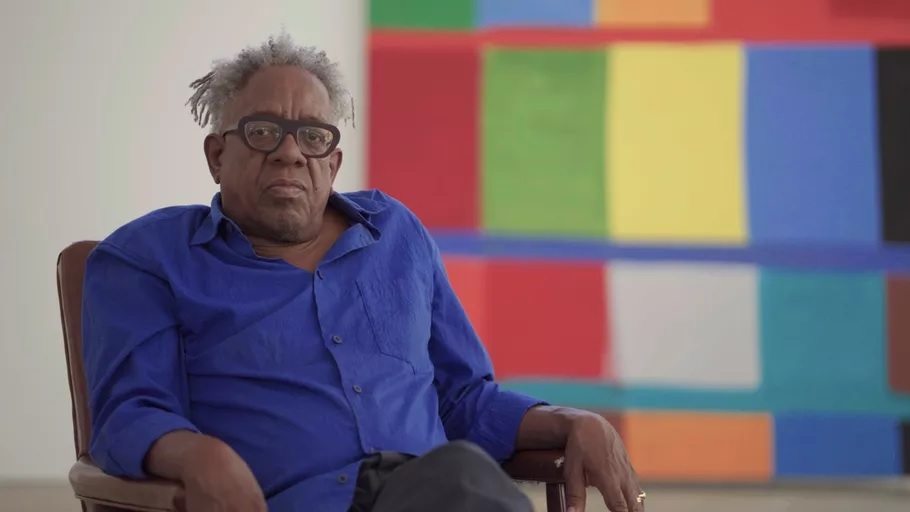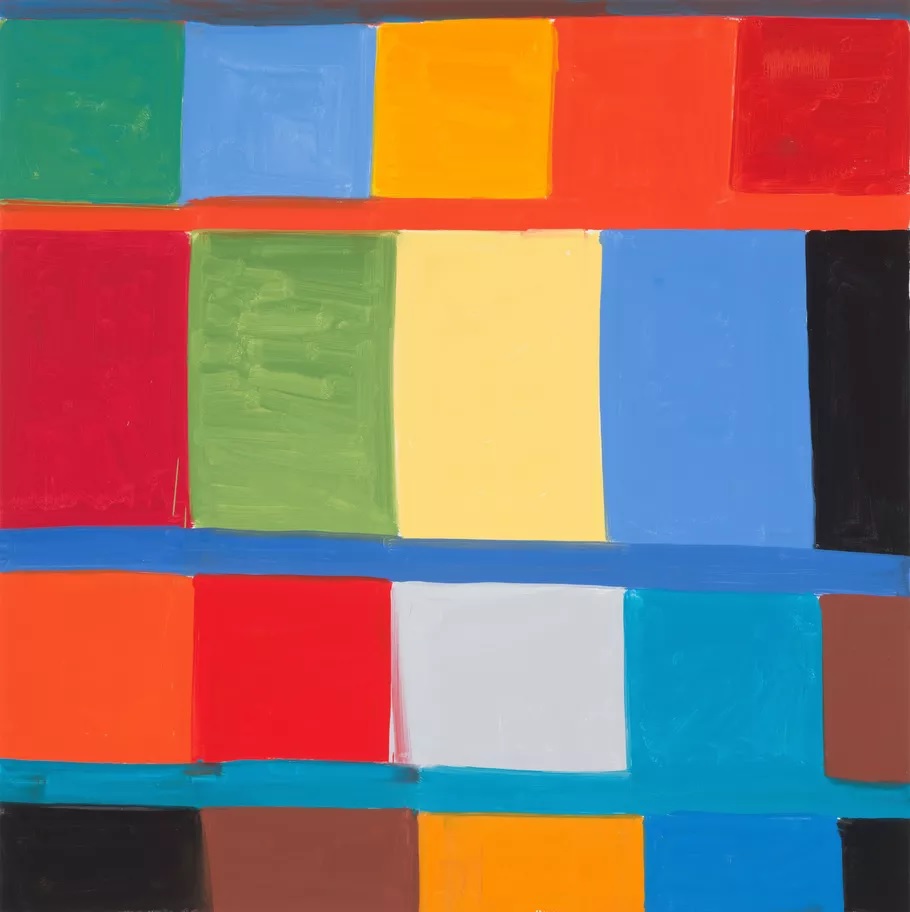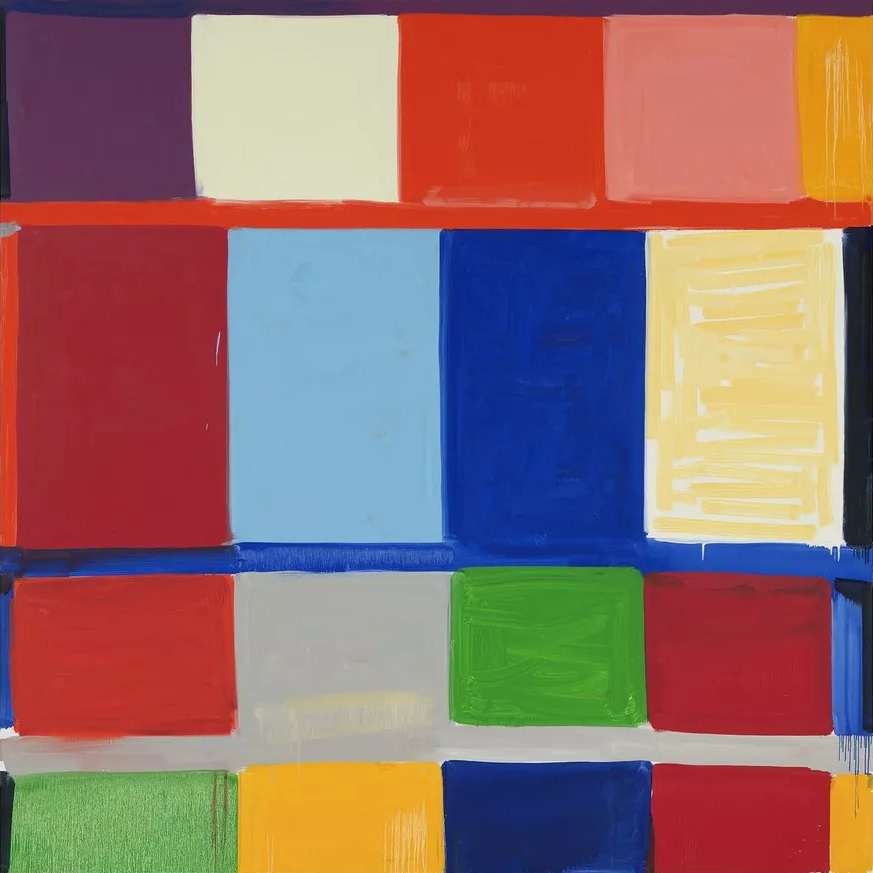
Portrait of Stanley Whitney in his studio by Pushpin Films. © Stanley Whitney. Courtesy of Gagosian.
Stanley Whitney’s vibrant abstract paintings use blocks of color as a way to build rhythm and space on the canvas. The artist likens his painting approach to call and response, the legendary musical form used to sing hymns in Southern Black culture. In such songs, a singer calls out to the audience, beckoning them to chant back a phrase or lyric in response. By situating his painterly process in this way, as an extended interaction between himself and color, Whitney is able to use Black culture as a point of departure for his vigorous abstractions.
Whitney’s new painting The Freedom We Fight For (2022) is the focus of a new Artsy Spotlight Auction, in partnership with Gagosian, to benefit the Art for Justice Fund and Planned Parenthood of Greater New York. The striking, 80-square-inch painting is rendered in Whitney’s signature color-block style, featuring hues of red, yellow, green, orange, brown, black, and gray divided by horizontal lines of red, blue, and teal. The work is emblematic of the modernist grid, though at the same time, it deconstructs that historical form through its immersive use of color.
The title The Freedom We Fight For, Whitney explained, “refers to the time we’re living in, a time when human rights are under attack in this country.” In a new video, he describes the polarizing political landscape of today as a “a crucial time,” where we find ourselves “in the midst of a cold war between the left and the right.” He added, “If I can do something as an artist, I’m more than willing to donate a painting.”
To that end, Whitney chose Planned Parenthood of Greater New York for its work in providing reproductive health care, like abortion, but also for its family planning services. In addition, he chose the Art for Justice Fund to recognize the staggering number of imprisoned people in the United States, which outranks any other country. “They’re both fantastic organizations that I’ve supported in the past, and the work they’re doing is critical at this time,” Whitney noted. “I’m grateful to have the opportunity to support them with this auction.”

Stanley Whitney. The Freedom We Fight For, 2022.
Although he works with abstraction, Whitney finds ways to powerfully convey political and cultural arguments to his audiences. “I always title all of my work so that if you didn’t see the painting, you would still have a sense of who I am and where I come from,” he explained.
Born in Philadelphia in 1946, Whitney received his MFA from the Yale School of Art in 1972. His signature color-block style, which he frequently refers to as his “mature style,” did not emerge until the early 1990s, while he was living in Rome. It was at this time that the collision of space and color came to the fore of his work, inspired by interactions with Rome’s classical architecture. In addition to the city’s architecture, Whitney found inspiration in the work of Italian modernists like Giorgio Morandi and Black experimental jazz musicians like Charlie Parker, Miles Davis, and Ornette Coleman.

Stanley Whitney’s studio by Pushpin Films. © Stanley Whitney. Courtesy of Gagosian.
The improvisational nature of jazz music is not only Whitney’s soundtrack while he works, it also reflects his painting method. “I always start at the top and paint down,” he said of his process. This approach enables him to work with the colors and create a back-and-forth with the painting as it forms, akin to an improvised solo rather than a carefully orchestrated performance. He has said that the color dictates the space and its placement on the canvas.
Whitney’s early grid paintings from the 1980s feature delineated archways that seem to explode, creating a passageway. But over time, Whitney came to the conclusion that he didn’t need to use lines to define space; color alone more than sufficed. “My use of color has always been intuitive,” he told Artsy. “It’s about what feels right. Color has always been magic to me.”

Stanley Whitney. In Memory of Tomorrow, 2020.
Whitney’s style, though emerging in the 1970s and 1980s while the art world leaned into Conceptualism, was born from the painting traditions of the New York School. He cites Mark Rothko, Jackson Pollock, and Joan Mitchell as his primary reference points. However, the rigidness of those origins led Whitney to turn to other genres, ultimately leading to his now-iconic style. “There were so many rules in the New York School,” Whitney explained. “It really shaped me mentally as an artist. I learned the importance of having mental toughness, a conviction in the work I’m making, from the New York School.”
Whitney’s due recognition in the art world has only arrived in the past decade, during which time he’s exhibited and gained representation with major international galleries (he was represented by Lisson Gallery beginning in 2015, before he joined Gagosian earlier this year) and shown at institutions across the globe. That includes his groundbreaking solo museum exhibitions “Focus: Stanley Whitney” (2016) and “Dance the Orange” (2015) at the Modern Art Museum of Fort Worth and the Studio Museum in Harlem, respectively. This past spring, Whitney had a mesmerizing exhibition at the Palazzo Tiepolo Passi in Venice during the Biennale to commemorate the work that he has made in Italy across his career. For the past three decades, the artist has split his time between New York and Parma, Italy.

Portrait of Stanley Whitney in his studio by Pushpin Films. © Stanley Whitney. Courtesy of Gagosian.
Recently, Whitney’s secondary market has grown exponentially. In November 2021, Whitney’s auction record was set when the canvas Forward to Black (1996), measuring over seven feet in length, sold for more than $2.3 million, far exceeding its estimate of $150,000–$200,000 at Sotheby’s. That record was nearly matched in March of this year, when Nightwatch (2012) sold for £1.7 million ($2.3 million) at Sotheby’s “The Now” evening auction. In fact, the artist’s top 10 results at auction all occured over the past year, nine of which surpassed the million dollar mark.
As new audiences are exposed to Whitney’s fresh approach to abstraction, they are confronted with the foundational use of culture—from jazz to the Roman archways—across his practice. His charitable work, as seen in this latest auction and his 2020 online exhibition “No to Prisons,” in which proceeds also went toward the Art for Justice Fund, similarly function like a call and response. As Whitney himself said, abstraction has a political impact because it “[puts] everything into question.”
Source: Artsy







